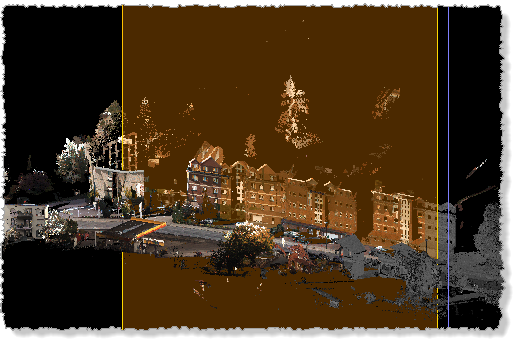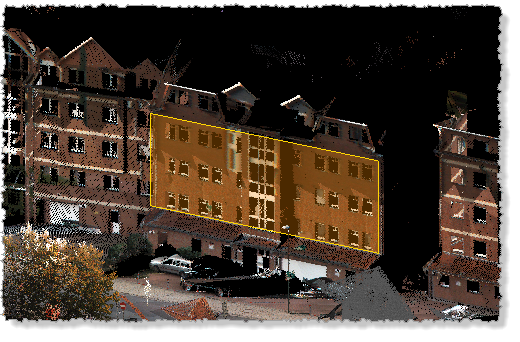Create Orthophotos from Point Clouds
Use the Create Orthophoto from Point Cloud command to create a 2D orthophoto (also referred to as an orthoimage) from a specified rectangle on a plane intersecting a dense point cloud. The command allows you to select the orthophoto type you want to create, define an appropriate plane in the point cloud, draw a rectangle to specify the real-world area on the plane to be covered, and select the pixel size for the resulting image.
After you create or import an orthophoto, you can optionally display it on the Cutting Plane View, where you can can make measurements and add text and linework to create deliverables. You can export the orthophoto using the Orthoimage exporter, or a DWG or DXF exporter, to share with other users. A text file that defines the coordinates (in meters) corresponding to the four corners of the image is also created to locate the image if it is imported back into a TBC project.
Prerequisites:
See the Subscription Plans page. For a license matrix by command, see the License page in the TBC Community. Also see View and manage licensed features.
To create an orthophoto from a point cloud:
- Select Create Orthophoto from Point Cloud in Point Clouds > Deliverables to display the Create Orthophoto from Point Cloud command pane.
- In the Orthophoto type drop-down list, select one of the following options for creating the orthophoto:
- True color - Create the orthophoto using true color.
- Depth - Create the orthophoto using a color scale based on the depth in the image of each scan point.
- Gray scaled intensity - Create the orthophoto using a gray scale based on the laser intensity (return signal strength) of each scan point. Low intensity points display in darker shades of gray; high-intensity points display in lighter shades of gray.
- Color coded intensity - Create the orthophoto using a color scale based on the intensity (return signal strength) of each scan point. Low intensity points display in warmer colors (for example, orange and yellow); high-intensity points display in cooler colors (for example, blue and green).
- In the Name field, enter the name for the resulting orthophoto files.
If you continue to use the same name for subsequent orthophoto files you create, the name for each new file will be appended with a sequential number.
- In the Plane Definition drop-down list, select the plane definition you want to use to create the orthophoto, or select <New...> to create a new plane definition.
This is the plane on which you will draw a rectangle representing the borders of the orthophoto you will be creating (for example, a plane on the face of a building).
The selected plane is displayed in the 3D View.

- In the Image rectangle fields, select a location or point (or enter a point ID) on the plane for each of the opposing corners of the rectangle that defines the borders for the orthophoto.
The rectangle is automatically oriented to the plane.

- In the Pixel size field, enter the pixel size (resolution) to be used for the orthophoto.
For example, if you enter .001, each pixel will represent a 1mm x 1mm real-world area on the plane. The smaller the pixel size, the higher the resolution and the larger the resulting image file.
The Image info field updates dynamically as you draw the rectangle and enter a pixel size:
- Rectangle size - This is the real-world size of the area selected on the plane with the rectangle controls.
- Image size - This is the real-world size of the area on the plane to be included in the orthophoto. It may vary from the Rectangle size due to rounding required based on the specified Pixel size. The larger the Pixel size, the greater the rounding will be.
- Image resolution - This is the horizontal and vertical pixel resolution for the resulting orthophoto. It is determined by the Rectangle size and Pixel size. The larger the Pixel size, the lower the resolution. The larger the Rectangle size, the higher the resolution.
- Total pixels - This is the total number of pixels in the resulting orthophoto. determined by multiplying the horizontal and vertical Image resolution values.
- Click the Store button.
Two new files are created in the project folder, each using the name specified in the Name field:
- A TIFF (.tiff) orthophoto file
- A text (.txt) file that defines the coordinates (in meters) corresponding to the four corners of the image
The orthophoto TIFF file is automatically imported into TBC and displays in the graphic views. You can use the View Filter Manager to display or hide orthophotos, or hide objects other than orthophotos. In addition, you can right-click an orthophoto node in the Project Explorer (nested beneath the Import node) to view its read-only properties and change background transparency and rendering settings.
At this point, you can, optionally, display the orthophoto in the Cutting Plane View to use it to make measurements and/or create overlying linework.
Note: If it is necessary to recreate the plane on which the orthophoto displays to view it in the Cutting Plane View (for example, the original plane was deleted or modified, or the orthophoto has been imported into your project), you can use the From planar object option in the Plane Definition Manager to select the orthophoto to recreate its original plane. If you want to select the orthophoto in a graphic view, you must ensure it is selectable in the Advanced View Filter Settings dialog.
You can use the the Orthoimage exporter to export the orthophoto to share with other users. Or, you can use the DWG or DXF exporter to export the orthophoto and any selected linework to AutoCAD. See Export Data for more information.